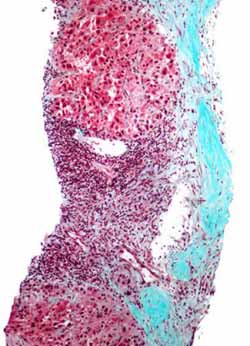A gene that fights cancer, but causes it too

In this low-magnification micrograph, normal liver architecture is disrupted by hepatocellular carcinoma, the most common type of liver cancer. Fibrotic late-stage cirrhosis is stained blue; tell-tale Mallory bodies (keratin filament proteins) are stained pink. Credit: UC San Diego School of Medicine<br>
An international team of researchers, led by scientists at the University of California, San Diego School of Medicine, and the Eastern Hepatobiliary Surgery Hospital in China, say a human gene implicated in the development of leukemia also acts to prevent cancer of the liver.
Writing in the May 17 issue of the journal Cancer Cell, Gen-Sheng Feng, PhD, UCSD professor of pathology, and colleagues in San Diego, Shanghai and Turin report that an enzyme produced by the human gene PTPN11 appears to help protect hepatocytes (liver cells) from toxic damage and death. Conversely, the same enzyme, called Shp2, is a known factor in the development of several types of leukemia.
“The new function for PTPN11/Shp2 as a tumor suppressor in hepatocellular carcinoma (HCC) stands in contrast to its known oncogenic effect in leukemogenesis,” said Feng. “It's a surprising finding, but one that we think provides a fresh view of oncogenesis. The same gene can have oncogenic or anti-oncogenic effects, depending upon cellular context.”
Previous studies had determined that PTPN11 was a proto-oncogene. That is, dominant active mutations in the gene had been identified in several types of leukemia patients, as was an over-expression of the gene product Shp2. Feng and colleagues looked to see what happened when Shp2 was knocked out specifically in hepatocytes in a mouse model.
The result wasn't good: The mice got liver cancer.
Strikingly, deficient or low expression of PTPN11 was detected in a sub-fraction of human HCC patient samples by researchers at the Eastern Hepatobiliary Surgery Hospital in Shanghai, China. That work was led by Hongyang Wang, MD, PhD and a professor of molecular biology.
“The liver is a most critical metabolic organ in mammals, including humans,” said Feng. “It has a unique regenerative capacity that allows it to resist damage by food toxins, viruses and alcohol. Shp2 normally acts to protect hepatocytes. Removing Shp2 from these liver cells leads to their death, which in turn triggers compensatory regeneration and inflammatory responses. That results in enhanced development of HCC induced by a chemical carcinogen.”
Feng said the findings highlight the unique mechanism underlying HCC, but more broadly, they reveal new complexities in how different types of cancer begin. Indeed, the researchers say their work also uncovered pro- and anti-oncogenic activities in a gene transcription factor called Stat3.
“Our results indicate a requirement for Stat3 in promoting HCC development, which is consistent with the literature saying Stat3 is pro-oncogenic. But we also found that deletion of Stat3 in hepatocytes resulted in a modest, but significant, increase in HCC.”
Feng said the findings underscore the need for caution in designing therapeutic strategies for treating HCCs and other types of cancers because the answer might also be the problem.
Funding for this study came, in part, from the National Institute of Diabetes and Digestive and Kidney Diseases, the National Institutes of Health and the National Natural Science Foundation of China.
Co-authors of the paper include Emilie A. Bard-Chapeau, UCSD Department of Pathology and Division of Biological Sciences and Sanford/Burnham Medical Institute, La Jolla; Shuangwei Li, Sharon S. Zhang, Helen H. Zhu, Diane D. Fang and Nissi M. Varki, UCSD Department of Pathology and Division of Biological Sciences; Jin Ding, Tao Han and Hongyang Wang, Laboratory of Signal Transduction, Eastern Hepatobiliary Surgery Hospital, Second Military Medical University, Shanghai, China; Frederic Princen and Beatrice Bailly-Maitre, Sanford/Burnham Medical Research Institute; Valeria Poli, Department of Genetics, Biology and Biochemistry, University of Turin, Italy.
Media Contact
More Information:
http://www.ucsd.eduAll latest news from the category: Life Sciences and Chemistry
Articles and reports from the Life Sciences and chemistry area deal with applied and basic research into modern biology, chemistry and human medicine.
Valuable information can be found on a range of life sciences fields including bacteriology, biochemistry, bionics, bioinformatics, biophysics, biotechnology, genetics, geobotany, human biology, marine biology, microbiology, molecular biology, cellular biology, zoology, bioinorganic chemistry, microchemistry and environmental chemistry.
Newest articles

Silicon Carbide Innovation Alliance to drive industrial-scale semiconductor work
Known for its ability to withstand extreme environments and high voltages, silicon carbide (SiC) is a semiconducting material made up of silicon and carbon atoms arranged into crystals that is…

New SPECT/CT technique shows impressive biomarker identification
…offers increased access for prostate cancer patients. A novel SPECT/CT acquisition method can accurately detect radiopharmaceutical biodistribution in a convenient manner for prostate cancer patients, opening the door for more…

How 3D printers can give robots a soft touch
Soft skin coverings and touch sensors have emerged as a promising feature for robots that are both safer and more intuitive for human interaction, but they are expensive and difficult…





















